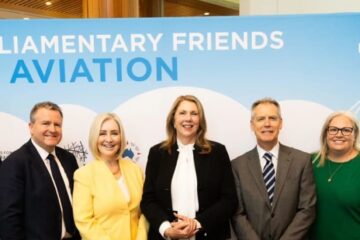Media Release 5 June 2024
Highlights
- New Evidence on Aircraft Noise: Research reveals that modern jets may emit more harmful low-frequency noise than older models, posing significant health risks.
- Health Impacts Identified: Chronic exposure to low-frequency aircraft noise is linked to cardiovascular disease, sleep disturbances, cognitive impairment, and mental health issues.
- Outdated Regulations: Current Australian standards inadequately address the full spectrum of aircraft noise, particularly the low-frequency range.
- New Metrics Proposed: Introduction of the dBH metric to measure health-damaging low-frequency noise, highlighting its energy and impact.
Main Summary of Findings
The most dangerous part of aircraft noise can’t even be heard by the human ear, but new research shows that low frequency noise does the most damage to our health.
A comprehensive study led by environmental scientist Dr Sean Foley highlights how commonly flown Qantas and Virgin jets such as the Boeing 737 emit sound waves in the low frequency and infrasound band (31 Hz to 200 Hz), which is unmeasured and unregulated under current Australian standards.
Key findings include:
- Dominance of Low-Frequency Noise: Modern aircraft emit significant levels of low-frequency noise (<500 Hz), which is more harmful than higher frequency noise due to its ability to travel further and carry more energy. This low-frequency noise is responsible for a wide range of health issues.
- Health Harms: Chronic exposure to low-frequency aircraft noise has been linked to:
- Cardiovascular Disease: Elevated risk due to chronic stress and disrupted sleep.
- Cognitive Impairment: Negative impacts on communication, learning abilities and concentration, particularly in school children.
- Mental Health: Increased levels of annoyance, stress, and anger among residents.
- Sleep Disorders: Significant disruption of sleep patterns, especially in urban areas affected by night flights.
- Comparative Analysis: Preliminary analysis comparing older aircraft (B737 and A320) with newer models (B737max and A320neo) indicates that while newer aircraft may have lower audible noise (measured in dBA), they still emit significant low-frequency noise. The proposed dBH metric (31 Hz to 200 Hz) shows that low-frequency noise is approximately twice as energetically significant as audible noise, emphasising the need for better regulatory measures.
- Regulatory Gaps: Australia’s current noise regulation standards are outdated and insufficient to address the full spectrum of aircraft noise pollution, particularly the low-frequency components.
- New Decibel Metric Proposal: The introduction of the dBH metric to complement the dBA metric is essential. This new metric focuses on the low frequency range of 31 Hz to 200 Hz, encompassing most of the health effects identified, and provides a more accurate representation of noise pollution’s impact on health.

Quotes Attributable to Dr Sean Foley
“Aircraft noise pollution is a silent killer. The audible aircraft noise annoying you is not the low frequency noise harming you. Chronic exposure to low-frequency aircraft noise is linked to cardiovascular disease, sleep disturbances, cognitive impairment, and mental health issues.”
“Aircraft noise pollution is a growing concern that goes beyond mere annoyance. Our research shows that the low-frequency components of this noise are particularly harmful, penetrating deeper into human tissue and disrupting essential bodily functions.”
“Australia is currently a global laggard in regulating aircraft noise pollution. Without modern standards and comprehensive monitoring, it is challenging to mitigate the adverse health effects experienced by our communities.”
“The adoption of a Full Spectrum Metric for measuring aircraft noise is a crucial step forward. It ensures that all harmful frequencies are accounted for, enabling more effective regulation and protection of public health.”
“Our findings call for urgent legislative action to implement and enforce noise pollution standards that reflect the latest scientific understanding of the health harms and impacts of aircraft noise.”
About the Report’s Author
Dr Sean Foley BSc (Hons) PhD FRGS is an esteemed Australian environmental scientist. His academic journey commenced with a Bachelor of Science with Honours from Murdoch University in Western Australia, followed by the successful completion of a PhD in Human Ecology at the Australian National University (ANU). Recognised for his exceptional contributions to geography and environmental science, Dr Foley was elected as a Fellow of the Royal Geographical Society (FRGS). His work is widely acknowledged in the academic community, with more than 2,600 citations and an h-index of 18. His extensive research portfolio includes numerous peer-reviewed publications in renowned scientific journals, reflecting his commitment to scientific communication and public outreach. Dr Foley’s interdisciplinary expertise spans natural resource and environmental management, environmental legislation, public health economics, international aid and development, policy analysis, and project design and management. He has also served as an Environmental Specialist with the World Bank, contributing his expertise to global environmental and developmental initiatives. Dr Foley’s leadership extends beyond academia; he has been an Executive Board Member of the Australia and New Zealand Society for Ecological Economics, and since 2003 a Fellow and now immediate ex-Chair of The Samdhana Institute.
About BFPCA
With the launch of Brisbane Airport’s New Parallel Runway on 12 July 2020 came a new airspace design and flight paths that concentrate aircraft noise over densely populated residential areas.
Brisbane Airport and Airservices Australia sold this project to Brisbane communities suggesting the New Parallel Runway will enable them to prioritise “over water” operations that direct planes away from residential areas. The CEO Gert-Jan de Graaff is on the record saying, “the net effect of aircraft flying over the city will decrease.”
Brisbane families and communities are suffering from excessive noise pollution and associated health and related impacts from Brisbane Airport’s new flight paths launched in July 2020. The Aircraft Noise Ombudsman report, the Brisbane Airport PIR Advisory Forum (BAPAF) and flight path design consultants TRAX International have all confirmed that Brisbane communities were misled using flawed noise modelling, deceiving community engagement, and offered inadequate noise abatements.
Brisbane Flight Path Community Alliance (BFPCA) came together in 2020 to fight back on behalf of all Brisbane families and communities experiencing this noise pollution.
For more background information, visit: https://bfpca.org.au/


